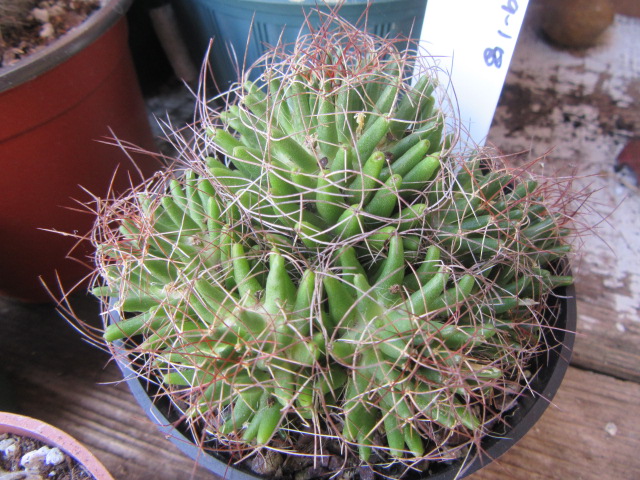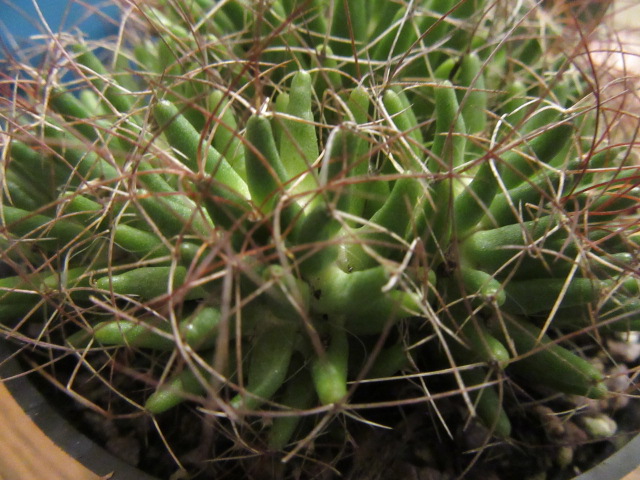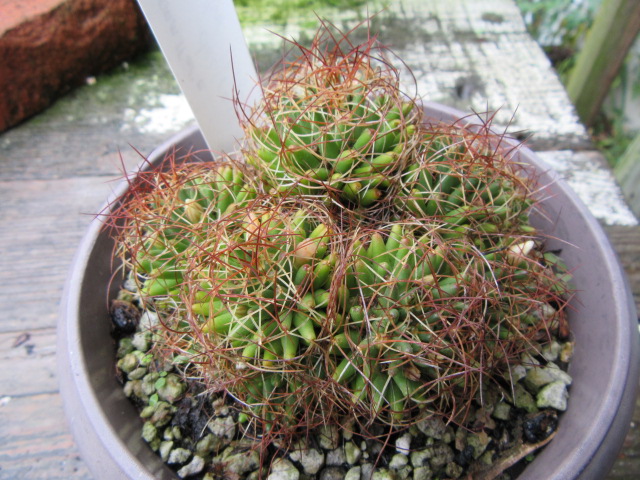
Mammillaria decipiens (syn. var. camptotricha)(Bird’s Nest Pincushion) after I brought it home on 3-19-18, #418-9.
Bird’s Nest Pincushion
Mammillaria decipiens
mam-mil-AR-ee-uh de-SIP-ee-enz
Possibly the synonym:
Mammillaria decipiens subsp. camptotricha
mam-mil-AR-ee-uh de-SIP-ee-enz kamp-toh-TRY-cha
Synonyms of Mammillaria decipiens (19) (Updated on 12-8-23 from Plants of the World Online): Cactus ancistrius Kuntze, Cactus decipiens (Scheidw.) Kuntze, Cactus guillemianus Kuntze, Chilita decipiens (Scheidw.) Orcutt, Dolichothele albescens (Tiegel) Backeb., Krainzia decipiens (Scheidw.) Doweld, Krainzia decipiens subsp. albescens (Tiegel) Doweld, Krainzia decipiens subsp. camptotricha (Dams) Doweld, Mammillaria albescens Tiegel, Mammillaria ancistria Walp., Mammillaria camptotricha Dams, Mammillaria decipiens subsp. albescens (Tiegel) D.R.Hunt, Mammillaria decipiens var. albescens (Tiegel) Repp., Mammillaria decipiens subsp. camptotricha (Dams) D.R.Hunt, Neomammillaria camptotricha (Dams) Britton & Rose, Neomammillaria decipiens (Scheidw.) Britton & Rose, Pseudomammillaria albescens (Tiegel) Buxb., Pseudomammillaria camptotricha (Dams) Buxb., Pseudomammillaria decipiens (Scheidw.) Buxb.
Mammillaria decipiens Scheidw. is the accepted scientific name for this cactus. It was named and described by Michael Joseph François Scheidweiler in Bulletins de l’Académie Royale des Sciences et Belles in 1839.
The genus, Mammillaria Haw., was named and described by Adrian Hardy Haworth in Synopsis Plantarum Succulentarum in 1812.
As of 12-8-23 when this page was last updated, Plants of the World Online by Kew lists 138 species in the Mammillaria genus. It is a member of the plant family Cactaceae with 150 genera. Those numbers are likely to change as updates are made on POWO. The number of species in the genus and genera in the family fluctuates off and on.
There are subspecies of Mammillaria decipiens that are now synonyms of the species. The Mammillaria decipiens in my collection seems to “have been” Mammillaria decipiens subsp. camptotricha (Dams) D.R.Hunt. It was named and described by Davis Richard Hunt in Mammillaria Postscripts in 1997. Hopefully, someday the botanists in charge of what names are accepted will recognize more infraspecific names (forms, subspecies, and varieties), which properly distinguish plant ID with different characteristics from the species. That’s why they were given different names in the first place (except for the species that were named more than once by different people)…
THERE ARE SEVERAL LINKS AT THE BOTTOM OF THE PAGE FOR FURTHER READING.

Mammillaria decipiens (syn. var. camptotricha)(Bird’s Nest Pincushion) on 3-21-18, #419-12.
I bought this cactus from Walmart on 3-19-18. It is a very interesting cactus. It’s like the main plant with maybe 5 smaller ones growing on one side. The cluster measures 1 1/2” tall x 3” wide. It has completely filled this 2 3/4” diameter x 2 1/4” tall pot, which is bulging. It has long white radial spines that grow sideways from the tubercles and brown central spines that stick out like stiff hair. Cactus that have protruding tubercles like this one are often called nipple cactus. OUCH!
USEFUL INFORMATION:
Family: Cactaceae
Origin: San Luis Potosi, Guanajuato, and Queretaro, Mexico. Eastern Mexico
Zones: USDA Zones 10a-11 (30-40° F)
Size:
Light: Light to part shade. Mine has been on the back porch in full sun during the summer and has done very well.
Soil: Fast-draining. Potting soil amended with pumice or perlite and chicken grit. Sources say to avoid the use of peat or other humus sources. GEEZ!
Water: Average during the summer, barely in winter.
You can read my Cactus Talk & Update and Cactus & Succulent Tips to get my opinion about growing cacti and succulents.
When you bring your new plants home from the store, you need to check their roots and the soil to see if they are wet. If so, you may want to re-pot it right away. It is advisable to re-pot them in a better potting soil more suitable for cacti and succulents.

Mammillaria decipiens (syn. var. camptotricha) (Bird’s Nest Pincushion) on 3-21-18, #419-10.
Information online says this cactus is a freely clustering species that builds up into a dense cluster of stems. It also says they do better than most species in lower levels of light but still prefer bright light or morning sun.

Mammillaria decipiens (syn. var. camptotricha) (Bird’s Nest Pincushion) on 5-17-18, #443-59.
Once warmer temperatures came I moved the plants back outside. I had put the Mammillaria decipiens in a larger pot earlier since the sides were bulging.

Mammillaria decipiens (syn. var. camptotricha) (Bird’s Nest Pincushion) with buds on 6-24-18, #463-5.
I was happy to see buds on the Mammillaria decipiens on June 24. I was even happier when I saw they weren’t going to be pink. 🙂

Mammillaria decipiens (syn. var. camptotricha) (Bird’s Nest Pincushion) on 6-28-18, #465-13.
Preferred soil for cactus can sometimes be hard to understand. Llifle says this species “likes very porous mineral substratum and avoid the use of peat or other humus sources in the potting mixture.” GEEZ! What is that supposed to mean? Try finding good potting soil without peat… There are many “recipes” online and I suppose most cactus and succulent enthusiasts do a lot of experimenting. I have been using 2 parts Miracle Grow or Schultz Potting Soil with 1 part perlite and 1 part chicken grit for many years. I can buy it in larger bags and it has timed-release fertilizer. I tried using other brands in the past but I didn’t like the results. Cactus and succulent enthusiasts do not recommend using peat-based products because. Most cactus collectors on the Facebook Group called Succulent Infatuation now recommend using pumice instead of perlite now. So, I ordered a bag of pumice from General Pumice. Some people say pumice doesn’t float to the top of the pot, but I can tell you from experience it does…

Mammillaria decipiens (syn. var. camptotricha) (Bird’s Nest Pincushion) on 6-28-18, #465-14.
Mammillaria decipiens are native to San Luis Potosi, Guanajuato, and Queretaro in Mexico where they grow at an altitude between around 5,085 to almost 8,000 feet above sea level (1550-2150 meters).

Mammillaria decipiens (syn. var. camptotricha) (Bird’s Nest Pincushion) on 6-28-18, #465-15.
In the wild, they can be found growing in canyons and on rocky hills usually in volcanic soil. They grow under bushes among other plant species that like the same conditions.

Mammillaria decipiens (syn. var. camptotricha) (Bird’s Nest Pincushion) on 6-28-18, #465-16.
The flowers closed up in the late afternoon/early evening and kind of look like little tulips.

Mammillaria decipiens (syn. var. camptotricha) (Bird’s Nest Pincushion) on 7-30-18, #488-14.
The Mammillaria decipiens has certainly been strutting its stuff with all the flowers. I am glad the flowers aren’t pink…

Mammillaria decipiens (syn. var. camptotricha) (Bird’s Nest Pincushion) on 10-10-18, #519-44.
I measured the cactus and succulents when I brought my potted plants inside for the winter on October 10. I always measure my cactus at least once a year. The cluster of Mammillaria decipiens measured 1 5/8″ tall x 3 3/4″ wide. It was 1 1/2” tall x 3” wide when I brought it home on March 19.

Mammillaria decipiens (syn. var. camptotricha) (Bird’s Nest Pincushion) on 11-29-18, #534-16.
November 29 was a very nice spring-like day so I took the cactus outside for a photoshoot. I was making a post about the differences between the cactus species in my collection.

Mammillaria decipiens (syn. var. camptotricha) (Bird’s Nest Pincushion) close-up on 12-1-18, #535-11.
Mammillaria decipiens subsp. camptotricha has very prominent tubercles and long spines which cover the entire plant (on more mature specimens). The species and other subspecies do not have these long radial spines, and this one in particular usually lacks central spines. As you can clearly see, my plant has long radial spines with no central spines, and, nice nipples. Sorry, I mean tubercles. 🙂
<<<<2019>>>>

Mammillaria decipiens (syn. var. camptotricha) (Bird’s Nest Pincushion) on 6-8-19, #584-7.
When the temps warmed up enough in May I moved the potted plants outside for the summer. It is already flowering… I put the Mammillaria decipiens on the back porch in full sun… Ummm… The recommendation is light to part shade.

Mammillaria decipiens (syn. var. camptotricha) (Bird’s Nest Pincushion) on 6-12-19, #587-2.
Most of the other Mammillaria bloom after I move them back inside for the winter but this plant flowers off and on throughout the summer.

Mammillaria decipiens (syn. var. camptotricha) (Bird’s Nest Pincushion) on 6-22-19, #593-26.
Description from Llifle (Encyclopedia of Living Forms):
Description: Mammillaria decipiens (a.k.a. Bird’s Nest Mammillaria) is a low-growing, prominently ‘nippled’ cactus species, with long, bristly spines that cross each other forming a sort of bird’s nest look (hence its common name).
Habit: Usually cespitose, sprouting unevenly from the base and sides, often forming large mounds.
Root: Very large, tuberose.
Stem: Individual stems, globose to club-shaped, rounded at the top, 6 to 10 cm high, 4-7(-10) cm in diameter, grass green to deep green.
Tubercles: Soft, cylindrical to obtuse, 10-22 mm long 5-7 mm in diameter, their axils bearing or sparse wool and 3 fine bristles each. Without latex.
Radial spines: 5 to 11, spreading, 7-15 mm long or as long as 30 mm, bristle-like, straight, slender, white to brownish-white, sometimes yellowish with brown tips, puberulent when young. *Mammillaria decipiens var. camptotricha has 4-5 radial spines, 30 cm long that are bristly…
Central spines: 1-2 rarely none, much longer than the radials, 10-27 mm long, straight, erect or ascending, slender, needle-like, bristly, dark brown.
Flowers: 15-18 mm, long, 10 mm across, broadly funnel-shaped, slightly scented; inner perianth-segments nearly white or faintly tinged with pink, acute; filaments white to pinkish; stigma-lobes 4, white or pinkish, slender, filiform. Flower-buds pinkish, acute.
Fruit: Cylindrical, reddish-green.
Seeds: Light brown.

Mammillaria decipiens (syn. var. camptotricha) (Bird’s Nest Pincushion) at 1 1/2″ tall x 4″ wide on 10-11-19, #639-56.
I had to move the potted plants inside for the winter on October 11 because an “F” was in the forecast. I always take photos of all the plants and measure the cactus and some of the succulents as I move them inside. The clump of Mammillaria decipiens measured 1 1/2″ tall x 4″ wide. Remember, it was only 3″ wide when I brought it home in March 2018. It did very well in full sun…

Mammillaria decipiens (syn. var. camptotricha) (Bird’s Nest Pincushion) on 10-11-19, #639-57.
This photo shows how long the radial spines are and how they weave across the plant. The spines of Mammillaria decipiens subsp. camptotricha are longer than the species which leads me to believe this is the subspecies… It also has 4-5 radial spines per tubercle whereas the species has 5-11. Maybe someday the subspecies will be accepted once again.

Mammillaria decipiens (syn. var. camptotricha) (Bird’s Nest Pincushion) on 10-19-19, #643-3.
It would be hard to say without seeing different plants of this species, especially in the wild. Is anyone up for a trip?

Mammillaria decipiens (syn. var. camptotricha) (Bird’s Nest Pincushion) in its new pot on 11-13-19, #649-13.
I put the Mammillaria decipiens in a larger pot on November 11 along with several other cacti. I kind of like repotting in the fall so their soil will be nice and loose over the winter. I mixed about half potting soil with half pumice. This one might actually have preferred to have some chicken grit as well…
<<<<2020>>>>

Mammillaria decipiens (syn. subsp. camptotricha) (Bird’s Nest Pincushion) at 1 3/4″ tall x 4 1/4″ wide on 10-15-20, #747-64.
I had to move the potted plants inside for the winter on October 15 (2020) because an “F” was in the forecast. As always, I took photographs and measurements as I brought the plants inside. The Mammillaria decipiens did very well over the summer and the tallest measured 1 3/4″ tall and the cluster of plants measured 4 1/4″ wide. That is 1/4″ taller x 1/4″ wider than last October 11.
<<<<2021>>>>

Mammillaria decipiens (syn. subsp. camptotricha) (Bird’s Nest Pincushion) on 6-24-21, #803-15.
The Mammillaria decipiens (subsp. camptotricha) was enjoying a day in the sun when the above photo was taken on 6-24-21. It had several buds.

Mammillaria decipiens (syn. subsp. camptotricha) (Bird’s Nest Pincushion) at 2″ tall x 4 1/2″ wide on 10-28-21, #853-12.
I didn’t have to move in the potted plants inside for the winter until October 28 in 2021. There wasn’t a chance “F” in the forecast until then which was quite unusual. The Mammillaria decipiens (subsp. camptotricha) did GREAT over the summer. The tallest plant in the cluster measured 2″ tall and the group expanded to 4 1/2″ wide. It is really hard to tell, but I believe we have a few new offsets.There were five plants in the cluster when I brought it home and I think there are 12 now.
UNFORTUNATELY, this cactus died over the summer of 2022. GEEZ!!! Hopefully, I can find another because it was great…
I will continue adding more photos and information as time goes by. The Llifle website (see link below) has a lot of useful information if you would like to know more. I will continue adding more photos and information as time goes by.
I hope you enjoyed this page and maybe found it useful. I would like to hear from you if you have any comments, questions, or suggestions. Please click on “like” if you visited this page. It helps us bloggers stay motivated. 🙂 You can check out the links below for further reading. The links take you directly to the genus and species of this plant.